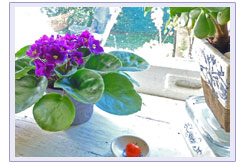Light Requirements for African Violets
 The amount of light that an African Violet receives is important for its health and overall performance. African Violets, like other plants, need light for photosynthesis.
The amount of light that an African Violet receives is important for its health and overall performance. African Violets, like other plants, need light for photosynthesis.
- African Violets perform best when they receive a lot of indirect sunlight.
- African Violets will only tolerate direct sunlight very early or very late in the day, but in all other cases should be shielded from direct sunlight.
- For best results, place your Violets in a window where they will receive light most of the day, i.e., a window with western or southern exposure.
- Adjust your blinds or use a sheer curtain to filter out some of the light.
African Violets will stop flowering and its leaves begin to turn yellow if they do not receive enough sunlight. In such circumstances, an it is also likely that the African Violet will become rangy as it develops elongated leaves and stems.
Troubleshooting
While insufficient sunlight can be harmful, too much sunlight can also cause problems. Too much sunlight will produce brown spots on the leaves and flowers - essentially giving the African Violet a sunburn. Too much sunlight can also cause the leaves to curl down and may turn variegated leaves entirely green.
- During the winter months, you may need to allow your African Violets to get more sunlight than they would ordinarily receive.
- Rotate your African Violet one-quarter turn, about once a week or each time you water. If African Violets are not rotated in this manner, they will begin to bend towards the light and grow larger on the side closest to the window.















